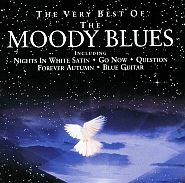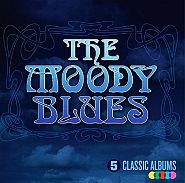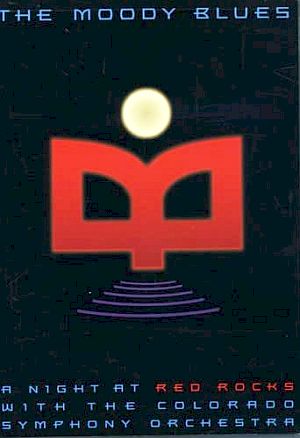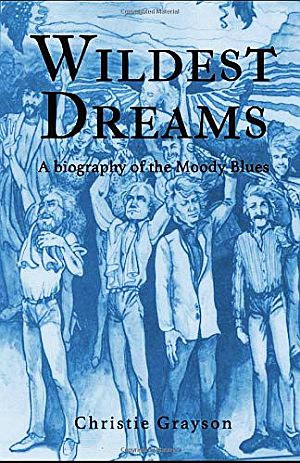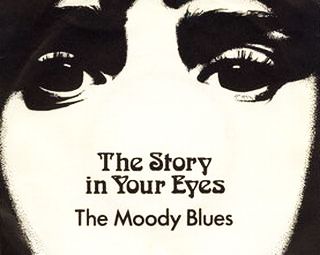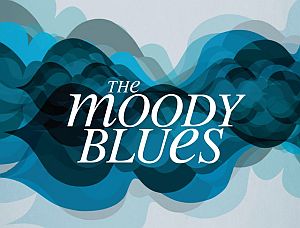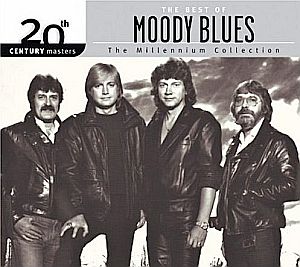In 2009, a Visa credit card TV ad used portions of a memorable 1967 Moody Blues tune that was paired nicely with some magical footage of sea creatures, as shown below. The ad, titled “Aquarium,” was done for Visa, and features a wide-eyed little girl with her father enraptured by what she is discovering in the colorful sea world before her. A Morgan Freeman voice-over makes the pitch for Visa. But in this ad, it is the Moody Blues song, “Tuesday Afternoon” – especially the song’s opening, other-worldly instrumental riff — combined with the colorful, floating sea creatures, that gives the scene a kind of mystical, even psychedelic quality.
The stunning photography of the sea creatures and their colorful underwater world in this ad, backed by the Moody Blues tune, provides a near “perfect fit” between image and music. And for aging Baby Boomers who may have come upon this ad by chance, or heard a slice of that opening riff, some old 1960s’ musical memory cells likely fired up. And those cells, upon awakening, might well have thought: …And for Baby Boomers who may have heard a slice of that opening riff, some old 1960s’ musical memory cells likely fired up…“Yeah, that’s the Moody Blues from the 1960s; that was pretty good music!.”
Indeed it was.
In fact, the Moody Blues, at the time “Tuesday Afternoon” was created, were in a new phase of their career that offered a new sound. But before getting to that point, they had a bit of a hard road to travel.
The Moody Blues were an R & B band founded in Birmingham, England in 1964. They had taken the name “Moody Blues” in part because their early music was blues-infused and also because member Mike Pinder’s favorite song was Duke Ellington’s “Mood Indigo.” The band had early success in 1964 with an R&B tune, “Go Now” (No. 1 UK, No. 10 U.S.). But little else of note followed for the group, as hard times rolled in with little money and few prospects. Two key members of the group also departed, and a new lineup emerged. By 1966, the new Moody Blues consisted of: Justin Hayward, vocals and guitar; John Lodge, bass, guitar, vocals; Ray Thomas, flute, percussion, harmonica, vocals; Mike Pinder, keyboards, vocals; and Graeme Edge, drums, percussion, vocals.
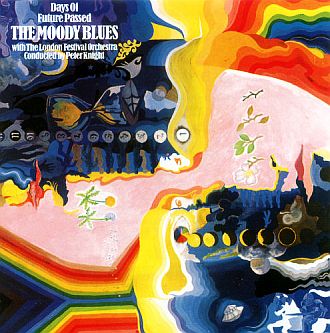
Appropriate 1960s artwork graces cover of Moody Blues’ ‘Days of Future Passed’ 1967 album, which first included the longer versions of both “Nights in White Satin” and “Tuesday Afternoon,” plus “Deramic sound.”. Click for album or singles.
And so, an album of the Moody Blues’ new materiel was undertaken, without Decca/Deram executives finding out until after the album was finished. That album became Days of Future Passed, which features orchestral/psychedelic rock ballads by Hayward, Pinder, Lodge, and Thomas with orchestral interludes by the London Festival Orchestra, Decca’s house orchestra, then consisting largely of session musicians. The album – regarded as one of the first “concept albums” – features a suite of songs organized around a day in the life of an everyday man – morning, afternoon, evening, night. It would also become one of the first “progressive rock” / “orchestral rock” albums of that era, bringing a new sound that would enthrall listeners and influence other musicians. Two songs would stand out, both written by singer-guitarist Justin Hayward – “Tuesday Afternoon” and “Nights in White Satin.”
|
“Nights in White Satin”
Nights in white satin Beauty I’d always missed ‘Cause I love you Gazing at people Some try to tell me And I love you Nights in white satin Beauty I’d always missed Yes I love you Yes I love you Breathe deep the gathering gloom Impassioned lovers wrestle as one Cold hearted orb that rules the night [ ending orchestral flourish ] |
Keyboardist Mike Pinder had written a song, “Dawn Is a Feeling” which became the starting point. Justin Hayward, meanwhile, then 19, would write what would become “Nights in White Satin,” first featured as “The Night,” near the end of the concept album. Hayward would also write what was first titled, “Forever Afternoon (Tuesday).” Those two songs, in particular, would become big hits that helped carry the album for many years.
Music Player
“Nights in White Satin” – 1967
The Moody Blues
Hayward at the time was between love interests, having ended one relationship and begun another. His earlier girlfriend, in fact, had given him a gift of satin bed sheets.
As Hayward would later explain in a Rolling Stone interview: “I was sharing a flat with Graeme [Edge] and two girls that we just met. The four of us were living together in two rooms… I remember coming back from a gig and sitting on the side of the bed and just writing the two verses to “Nights.” It was quite emotional. It was a whole series of random thoughts that were on my mind. I was at the end of one big love affair and at the beginning of another…”.
Recording sessions for the album took place at Decca Studios in London, between May and November 1967. The album, which featured songs for the morning, afternoon, twilight, and evening included songs reflecting that progression by Lodge and Thomas in addition to those of Pinder and Hayward.
Days of Future Passed, and the “Nights in White Satin” single, were both released in the UK in November 1967. And at first, neither set the world on fire. The single, on the Deram label, did make it to the top 50 on the UK singles chart by January 1968, edging up to No 35, and reaching No.19 by February 20, 1968. It did better elsewhere in Europe in 1968, hitting No.1 in Holland, and reaching the Top 10 in Austria, Belgium and Switzerland. It was the Moodies’ first significant chart achievement since 1964’s “Go Now.”
But in the U.S., where the single was released some months later, in April 1968, it was barely noticed, only reaching No. 103. But that would change in subsequent rounds.
In fact, it wasn’t until 1972, after their Seventh Sojourn album was out, that “Nights in White Satin” began to take off in the U.S., as Graeme Edge would explain to Rolling Stone in 2018:
…There used to be things [in the radio business] called regional breakouts. Instead of the big conglomerate radio stations like now, there were these FM guys and they had their own playlists. DJs were stars in those days and they prided themselves on discovering new talent. We had a regional breakout [ for “Nights in White Satin”] in Seattle. I think after the breakout started happening, there was a decision to re-promote it in other areas. It spread from Seattle down to San Francisco and down to L.A.. It was going great everywhere, slowly going up the charts again until in the end it got to Number Two. But it sold a hell of a lot of records because it took so long to get up there.”
The “progressive” FM radio DJs, at that time, would play longer songs and even entire albums without interruption, which as Edge notes, helped boost “Nights in White Satin,” which ran for 5:38 (and more than 7 minutes with the spoken word addition), and album sides more than 20 minutes.
In the same Rolling Stone interview, Justin Hayward added: “[The label] put all their promotion behind Seventh Sojourn and none behind ‘Nights,’ and it kind of backfired on them a bit. In ’72 it just grew and grew and grew and in the end everybody at the record company just had to hold up their hands and go, “OK, let it go.” It was wonderful, it [i.e., “Nights”] was all by itself. There was no promotion involved at all.”
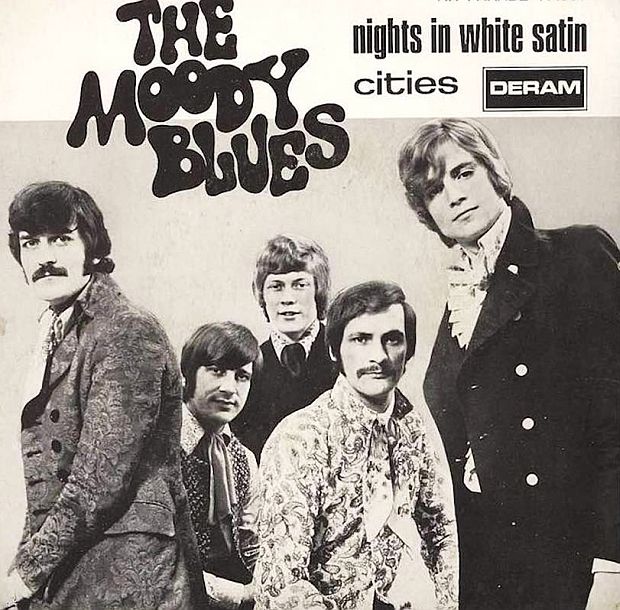
The Moody Blues in the costume garb of the late 1960s – from left: Ray Thomas, Mike Pinder, John Lodge, Graeme Edge, and Justin Hayward -- as they appeared on the record sleeve for “Nights in White Satin” single. Click for Amazon page.
In the end, “Nights in White Satin” would chart three different times in the U.K. – when first released in 1967 at No. 19; then to No. 9 in 1972; and finally, again in 1979 to No.14. It would also do well in the U.S. in 1972, reaching No. 2 on the Billboard Hot 100 and No. 1 on Cash Box, selling several million copies in the process. And later it would be used in the soundtracks of popular films, such as A Bronx Tale (1993) and Casino (1995), also covered by various artists, ranging from Giorgio Moroder and Tori Amos to Ramsey Lewis and Celtic Thunder.
And years later, through the 2000s and 2010s, “Nights in White Satin” continued to resonate with music fans around the world. Comments found at any of the YouTube offerings of the song, at Lost.fm, or other music websites, provide ample evidence of how the song, and the group generally, is revered among listeners for all sorts of reasons. “Nights in White Satin” would become the group’s signature song.As for the album, Days of Future Passed, it rose to No. 3 on the U.S. Billboard 200 chart and became the group’s breakthrough album of that time. According to the Rock n Roll Hall of Fame, Days of Future Passed “remained on the Billboard album charts for… five years” and would influence subsequent groups such as Yes, Genesis, and ELO. Critics have called it “a landmark album in the development of symphonic rock” that had an impact throughout the industry.
But another single coming out of that same album, released later than “Nights in White Satin,” also became a well-known Moody Blues hit – “Tuesday Afternoon” – also written and sung by Justin Hayward.
Tuesday Afternoon
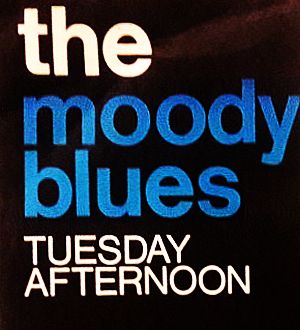
Portion of the 45 rpm record sleeve for Moody Blues’ 1968 hit single, “Tuesday Afternoon.” Click for single.
Given the “day-in-the-life” theme of Days of Future Passed, this song was originally titled “Forever Afternoon (Tuesday)” on the album, with the narrator singing about what he sees and feels that afternoon.
Music Player
“Tuesday Afternoon,” 1967-68
The unique opening instrumental sound of “Tuesday Afternoon” – used to good effect in the 2009 aquarium TV ad shown above – is a pleasing, but unique rolling instrumental sound (almost as if under water) which derives from the Mellotron, a keyboard instrument capable of duplicating the sound of various orchestral instruments, including violins, flutes, cellos, and even choirs. The Mellotron keyboard triggers taped loops of a chosen instrument recorded at different pitches. In “Tuesday Afternoon,” the recorded loops are strings, and according to one source, the strange and unique quality of the sound comes from the warble in the tape loops as they are played back. The Moodies were one of the first groups to use a Mellotron in their music, and it became a signature part of their sound in the late 1960s and early 1970s.
In the U.K., “Tuesday Afternoon” wasn’t released as a single at the time of the album’s release in 1967, and it would not appear on the UK singles charts. But in America and Canada, when it came out as a single in 1968, it received solid airplay. On the Billboard Hot 100, it rose to No. 24 and in Canada, to No. 12. It did better in selected cities, according to Vancouver Pop Music – No. 1 in Bakersfield (CA) and Dayton (OH); No. 2 in Boston and Pueblo (CO), No. 3 in Vancouver (BC) and Providence (RI); No. 4 in San Bernardino (CA) and Miami, Los Angeles and San Diego; No.5 in Cincinnati (OH) and Ann Arbor (MI), No. 6 in Edmonton (AB), Fort Lauderdale (FL) and Tucson (AZ), No. 7 in San Francisco, Chicago, Winnipeg (MB) and Columbus (OH); No. 8 in Minneapolis/St. Paul; and No. 9 in Worcester (MA), Indianapolis (IN), Houston and San Jose (CA).
|
“Tuesday Afternoon” Tuesday afternoon Something calls to me I’m looking at myself, So gently swaying through Tuesday afternoon Tuesday afternoon Something calls to me […flute-led, orchestral ending ] |
Justin Hayward has stated that as the album Days of Future Passed was going into production, he wrote “Tuesday Afternoon” while visiting Lypiatt Park, in western England – a park he had visited as a child; a place with an old Tudor manor house, rolling green hills, and large trees. The visit helped inspire Hayward with the verse, and over the years, it has been subject to many interpretations.
“Tuesday Afternoon” evokes an awakening of sorts in the narrator/visitor; a feeling that he is “in the moment” of an outdoor experience and having a bit of an epiphany – about his life, the passing of time, his relation to people, nature, and the rest of the world. Says he: “I’m just beginning to see / Now I’m on my way.”
One reviewer, Ray McCinnis of Vancouver Signature Sounds, suggests this visitor’s Tuesday afternoon has become “a time of deeper clarity and vision;” a time in which “new priorities emerge.” Among his new outlook, is a new relationship with nature: “The trees are drawing me near / I’ve got to find out why.” McGinnis also suggests that “clouds” are a metaphor for the obstacles that have blocked the narrator’s seeing things clearly in his life so far, thus this day’s epiphany helps with “chasing the clouds away.”
This song also contrasts with the previous track and set up at the end of the album’s Side One, “Lunch Break: Peak Hour,” which focuses on life’s problems and the rat race. Tuesday in the park, by contrast, put things in perspective, helping to leave one’s troubles behind, and appreciate the beauty and grace of the natural world – “the kind of day to leave myself behind.”
All in all it’s a song that seems a call to the rejuvenating qualities of the natural world and an appreciation of its beauty – available, for those who look, any day of the week.
Meanwhile, for many Moody Blues fans, the song holds a special place among their favorites, and for some, memorable associations from when they first heard it. Here’s a response to the song from one YouTube listener from 2012, posting as “J Wilman”:
…One morning back in 1977 while driving across the Oakland Bay Bridge, heading into San Francisco for work, this song came on the radio. The sun had just started to rise and reflected off the windows in the skyscrapers. Crystal clear day, not a cloud in the sky. Then it hit me. It was a Tuesday. Not afternoon yet, but definitely a Tuesday. I can’t begin to describe the feeling that came over me. Kind of a rush at first, and then for whatever reason, I became extremely melancholy. 35+ years later, the memory is as fresh as if it had just happened yesterday. Such a beautiful song!
“…I always heard a message of life-affirming hope in their music, and that helped me get through some hard times….”Another YouTube listener of the song, Walter Taylor, wrote as follows: “These guys are musical treasures that enriched my life. Now 69, I always heard a message of life-affirming hope in their music and that helped me get through some hard times. Now I can kick back to let the memories and melodies soothe my brain…” David from Deerfield Beach, Fl, posted comments at SongFacts.com on the song and Moody Blues music generally, noting in part: “…Living up to their name, they were sometimes haunting, deep, dark & melancholy, but in a beautiful, uplifting way. The orchestration had a rich, soothing sound…”. Other random comments on the song from YouTube listeners, include: “…Another timeless classic from the Moody Blues”; “,,,,[M]akes my heart ache with nostalgia”; “…I’m 65 now and I’ll never forget this song”; “…Pure magic …” On several of the online video postings of this song, there are thousands of similar comments.
Meanwhile, some professionals have also had high praise for “Tuesday Afternoon.” In June 2022, Brian Kachejian, a music critic with Classic Rock History, rated “Tuesday Afternoon” as the Moody Blues’ greatest song, noting that “Justin Hayward’s beautiful lyrics and melody, combined with John Lodges’ guitar work and Mike Pinder’s Mellotron, presented Moody Blues fans with the group’s grandest work and quite simply, the finest recording of the band’s long career.” Nick DeRiso, a music critic with Ultimate Classic Rock, rating the top 10 Moody Blues songs, in 2013, placed “Tuesday Afternoon” as their 4th greatest song.
Not all critics have loved them, however, some offering high disdain for what they believed were “over–the-top” sentiments and pretentious “messages-from-on-high” with poetry and spoken-word intrusions. But as the Rolling Stone Encyclopedia of Rock n Roll has noted, “the Moody Blues have proved impervious to the long prevalent critical view that their music is bombastic and pretentious.”
1967-1972
Their “Second Act”
In any case, 1967-1968, with Days of Future Passed and its hit songs, was a key turning point for the Moody Blues. They were just beginning their “second act” period from their “Go Now” days of 1964. Now they were marked as innovators and leaders in what would be variously called “progressive” and “orchestral” rock. The late 1960s, generally, was a heady time for rock `n roll, as The Beatles, The Beach Boys, The Doors, Jim Hendrix, Jefferson Airplane, The Byrds, Cream, were all producing innovative music and new albums of one kind or another. And through the 1970s the Moody Blues continued to turn out new albums at a rate of about one every year between 1968 and 1972..
|
The Moody Blues Days of Future Passed |
Their 1968 album, In Search of the Lost Chord, included “Legend of a Mind,” a song written by Ray Thomas about LSD guru Timothy Leary. Hayward’s “Voices in the Sky” charted as a single in the UK (No. 27), as did John Lodge’s “Ride My See-Saw” (No. 42, No. 15 in France).
Two more albums came in 1969. The first, On the Threshold of a Dream, became their first No. 1 album in the UK, and their second that year, To Our Children’s Children’s Children, was a concept album inspired by the first Moon landing.
A Question of Balance arrived in 1970, and topped the UK charts at No. 1, while hitting No. 3 in the U.S. as the band’s following increased there. Justin Hayward’s “Question” was the lead single from this album, reaching No. 2 in the UK. Pinder’s “Melancholy Man” would also be released as a single in France, reaching No. 1 there. By this time, the Moodies were receiving top billing, performing, for example, at both the 1969 and 1970 Isle of Wight festivals.
Their 1971 album, Every Good Boy Deserves Favour, became the band’s second consecutive, and third overall, No. 1 album in the UK and also reached No. 2 in the U.S., their highest posting there. Included was Hayward’s “The Story in Your Eyes,” a single from that album, hit No. 23 in the U.S. In 1972, Seventh Sojourn became their first album to reach No. 1 in the U. S., also reaching No. 5 in the UK. John Lodge’s songs, “Isn’t Life Strange” and “I’m Just a Singer (In a Rock `n Roll Band),” became successful singles from Seventh Sojourn, both reaching the Top 40 in the UK and the U.S.
Following Seventh Sojourn, a pause came for the group, resulting in about a three-year hiatus, a time when each of its members also tried solo work and/or collaborative projects. In 1978 the Moody Blues regrouped for their Octave album, which did well, including the single, “Steppin’ in a Slide Zone,” hit No.39. A subsequent U.S. tour followed, but Pinder, then involved with family, did not tour and would later leave the group and was replaced.
|
Rock Hall of Fame The Moody Blues were inducted into the Rock n Roll Hall of Fame in 2018. As their induction essay and career profile explained, in part: “…[T]his British quintet pondered the riddles of existence with thought-provoking lyrics and bracing, adventurous music…Their vast body of songs offered a counterpoint of hopefulness and idealism to darker currents of a warring and polluted planet. Few artists of their stature devoted themselves so assiduously to shining the light of love on a fraught, despairing world. But they also set rock on a boldly progressive course, infusing it with symphonic grandeur and experimental reach.” |
But the Moody Blues were not finished after their run of albums and touring in the 1970s. There would, in fact, be a ”third act” and a new round of success that would follow for this group in the mid-1980s. More on that period may appear in a future story at this site. Stay tuned.
For now, there are two other stories at this website that include Moody Blues content and music. “Legend of a Mind” uses the 1968 Moody Blues song of that name as intro to a longer story about its subject, Timothy Leary, and his role in the 1960s as an LSD/counterculture proponent. And “The Story in Your Eyes” is a 1971 Justin Hayward tune that has, in part, an environmental and “fate-of-the-planet” message. Additional story choices in music can be found at the “Annals of Music” category page.
Thanks for visiting – and if you like what you find here, please make a donation to help support the research, writing, and continued publication of this website. Thank you. – Jack Doyle
|
Please Support Thank You |
Date Posted: 7 September 2023
Last Update: 17 January 2024
Comments to: jackdoyle47@gmail.com
Twitter: https://twitter.com/PopHistoryDig
Article Citation:
Jack Doyle, “The Moody Blues: Breakout Music,
1967-1972,” PopHistoryDig.com, September 7, 2023.
____________________________________
The Moody Blues at Amazon.com…
Sources, Links & Additional Information
“VISA Aquarium by Velvet,” (TBWA/Chiat/ Day), IdN Magazine, YouTube .com, March 25 2009.
VISA “Aquarium” (director’s cut), Velvet.de.
“The Moody Blues,” in Holly George-Warren and Patricia Romanowski (eds), The Rolling Stone Encyclopedia of Rock & Roll, Rolling Stone Press, New York, 3rd Edition, 2001, pp. 665-667.
Ailsa Chang, Host, “‘On ‘Mellotron Variations,’ A 1960s-Era Instrument Makes A Comeback,” National Public Radio / NPR.org, November 5, 2019.
Barbara Rowes, “A Requiem for the Moody Blues And the Days of Future Passed,” New York Times, Sunday, November 24, 1974, Section: RC, p. 505.
Robert Palmer, “Moody Blues Off Record,” New York Times, November 29, 1978.
“The Moody Blues,” Last.FM.
“The Moody Blues,” Wikipedia.org.
“Nights In White Satin,” The Moody Blues, Posted by Universal Music Group, YouTube .com, October 30, 2018.
“Nights in White Satin by The Moody Blues,” SongFacts.com.
“Tuesday Afternoon,” SongFacts.com.
https://www.songfacts.com/facts/the-moody-blues/tuesday-afternoon
Jordan Runtagh, “The Moody Blues’ ‘Nights in White Satin’: An Oral History. Band members Look Back at the Creation and Reception of Their Unlikely 1967 Symphonic-Rock Smash,” RollingStone.com, April 9, 2018.
Stephen Holden, “Rock: The Moody Blues,” New York Times, October 9, 1986, p, C-15.
Rob Jones, “The Moody Blues Play ‘Tuesday Afternoon’;” TheDeleteBin.com, March 3, 2011.
“If You Like the Moody Blues, Try Alt-J,” NewYorkTimes.com, January 16, 2013.
Nick DeRiso,”Top 10 Moody Blues Songs,” UltimateClassicRock.com, August 31, 2013.
Scott Mervis, “Denny Laine Talks Wings, Moody Blues, ‘Band on the Run’ Tour,” Pittsburgh Post-Gazette, May 3, 2017.
Phil Bausch, “The Moody Blues…Rock & Roll Hall of Fame,” OnTheRecords.net, October 7, 2017 (updated, December 13, 2017).
Andy Greene, “Moody Blues’ Justin Hayward on Rock & Roll Hall of Fame Honor: ‘It’s Amazing!’,” Rolling Stone, December 13, 2017.
“Moody Blues, Induction, 33rd Annual Induction Ceremony, Rock & Roll Hall of Fame,” RockHall.com, April 14, 2018.
Ray McGinnis, “#441: Tuesday Afternoon by the Moody Blues,” VancouverSignature Sounds.com, May 29, 2020.
Parke Puterbaugh / HOF Essay, “The Moody Blues: Avatars and Copilots of What Might Be Called Rocks’ Enlightenment, The Innovative Band Fused It’s Sound With Symphonic Grandeur and Experimental Reach,” Rock & Roll Hall of Fame / RockHall.com, 2018.
“Inductee Insights: The Moody Blues,” The Rock and Roll Hall of Fame / RockHall.com, July 22 2020.
“The Moody Blues’ Most Iconic Album Hits a Milestone,” GoldmineMag.com, September 5, 2017.
Michael Hann, “How the Moody Blues’ Nights in White Satin Became a Standard,” Financial Times, April 9, 2018.
Brian Kachejian, “Top 10 Moody Blues Songs,” ClassicRockHistory.com, June 2022.
Paul Sexton, “‘Nights In White Satin’: The Story Of The Moody Blues’ Epic Signature; It Was No Instant Success, But Gradually, the Group’s New Marriage of Pop and Orchestral Ingredients Began to Turn Heads,” UDiscover Music.com, November 10, 2022.

